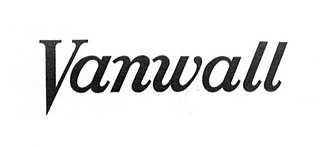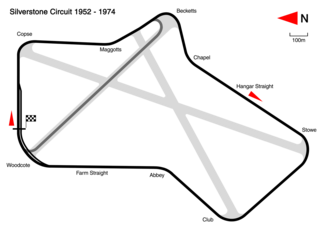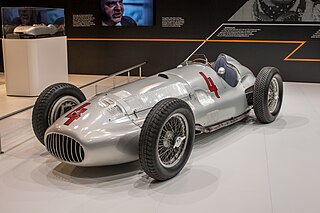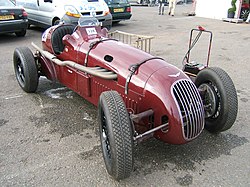The Tyrrell Racing Organisation was an auto racing team and Formula One constructor founded by Ken Tyrrell (1924–2001) which started racing in 1958 and started building its own cars in 1970. The team experienced its greatest success in the early 1970s, when it won three Drivers' Championships and one Constructors' Championship with Jackie Stewart. The team never reached such heights again, although it continued to win races through the 1970s and into the early 1980s, taking the final win for the Ford Cosworth DFV engine at Detroit in 1983. The team was bought by British American Tobacco in 1997 and completed its final season as Tyrrell in 1998. Tyrrell's legacy continues in Formula One as the Mercedes-AMG F1 team, who is Tyrrell's descendant through various sales and rebrandings via BAR, Honda and Brawn GP.

Vanwall was a British motor racing team and racing car constructor that was active in Formula One during the 1950s. Founded by Tony Vandervell, the Vanwall name was derived by combining the name of the team owner with that of his Thinwall bearings produced at the Vandervell Products factory at Acton, London. Originally entering modified Ferraris in non-championship races, Vanwall constructed their first cars to race in the 1954 Formula One season. The team achieved their first race win in the 1957 British Grand Prix, with Stirling Moss and Tony Brooks sharing a VW 5, earning the team the distinction of constructing the first British-built car to win a World Championship race. Vanwall won the inaugural Constructors' Championship in Formula One in 1958, in the process allowing Moss and Brooks to finish second and third in the Drivers' Championship standings, each winning three races for Vanwall. Vandervell's failing health meant 1958 would be the last full season; the squad ran cars in a handful of races in the following years, but finished racing in 1961.

Formula Two is a type of open-wheel formula racing category first codified in 1948. It was replaced in 1985 by Formula 3000, but revived by the FIA from 2009–2012 in the form of the FIA Formula Two Championship. The name returned again in 2017 when the former GP2 Series became known as the FIA Formula 2 Championship.

Coventry Climax was a British forklift truck, fire pump, racing, and other speciality engine manufacturer.

George Edgar Abecassis was a British racing driver, and co-founder of the HWM Formula One team.

The 1952 British Grand Prix was a Formula Two race held on 19 July 1952 at Silverstone Circuit. It was race 5 of 8 in the 1952 World Championship of Drivers, in which each Grand Prix was run to Formula Two rules rather than the Formula One regulations normally used.
Geoffrey Crossley was a British racing driver from England. He participated in two World Championship Formula One Grands Prix, debuting on 13 May 1950. He scored no championship points. He also participated in numerous non-Championship Formula One races.

Hersham and Walton Motors (HWM) is the world's longest established Aston Martin business, having acquired the franchise in 1951. As a racing car constructor, HWM competed in Formula One and Formula Two, and in sports car racing.

Connaught Engineering, often referred to simply as Connaught, was a Formula One, Formula Two and other sports car divisions constructor from the United Kingdom. Their cars participated in 18 Grands Prix, entering a total of 52 races with their A, B, and C Type Formula 2 and Formula 1 Grand Prix Cars. They achieved 1 podium and scored 17 championship points. The name Connaught is a pun on Continental Autos, the garage in Send, Surrey, which specialised in sales and repair of European sports cars such as Bugatti, and where the cars were built.

Formula racing is any of several forms of open-wheeled single-seater motorsport. The origin of the term lies in the nomenclature that was adopted by the FIA for all of its post-World War II single-seater regulations, or formulae. The best known of these formulae are Formula One, Formula E, Formula Two, Formula Three, regional Formula Three and Formula Four. Common usage of "formula racing" encompasses other single-seater series, including the IndyCar Series and the Super Formula Championship.

The Ferrari 500 was a Formula 2 racing car designed by Aurelio Lampredi and used by Ferrari in 1952 and 1953, when the World Championship was run to F2 regulations.

The McLaren M2B was the McLaren team's first Formula One racing car, used during the 1966 season. It was conceived in 1965 and preceded by the M2A development car. Designed by Robin Herd, the innovative but problematic Mallite material was used in its construction. The car was powered by Ford and Serenissima engines but both lacked power and suffered from reliability issues.

The Maserati 4CL and its derived sister model the Maserati 4CLT are single-seat open-wheel Grand Prix racing cars that were designed and built by Maserati. The 4CL was introduced at the beginning of the 1939 season, as a rival to the Alfa Romeo 158 and various ERA models in the voiturette class of international Grand Prix motor racing. Although racing ceased during World War II, the 4CL was one of the front running models at the resumption of racing in the late 1940s. Experiments with two-stage supercharging and tubular chassis construction eventually led to the introduction of the revised 4CLT model in 1948. The 4CLT was steadily upgraded and updated over the following two years, resulting in the ultimate 4CLT/50 model, introduced for the inaugural year of the Formula One World Championship in 1950. In the immediate post-war period, and the first two years of the Formula One category, the 4CLT was the car of choice for many privateer entrants, leading to numerous examples being involved in most races during this period.

The Mercedes-Benz W154 was a Grand Prix racing car designed by Rudolf Uhlenhaut. The W154 competed in the 1938 and 1939 Grand Prix seasons and was used by Rudolf Caracciola to win the 1938 European Championship.

The BRM Type 15 was a Formula One racing car of the early 1950s, and the first car produced by British Racing Motors. The car was fitted with a revolutionary and highly complex supercharged 1.5-litre British Racing Motors V16 which produced considerably more power than any of its contemporaries.

The Williams FW09 was a Formula One car designed by Frank Dernie and Neil Oatley. It was the first Williams chassis to be powered by a turbocharged Honda V6 engine, for which Frank Williams negotiated a deal towards the end of 1982 and the beginning of 1983.

The GP3 Series, or GP3 for short, was a single-seater motor racing series launched in 2010 as a feeder series for the GP2 Series, introduced by GP2 organiser Bruno Michel. GP3 followed the entire European leg of the Formula One series and the GP2 series as a support race for the two. Like the GP2 series, GP3 gave drivers the experience of the Grand Prix environment, and took advantage of the infrastructure, such as marshals and medical facilities, in place for the Formula One events. GP3 Series mainly raced on European circuits, but had appearances on other international race tracks, with rounds in the 2015 season at the Bahrain International Circuit in Bahrain and the Yas Marina Circuit in United Arab Emirates.

The Lamborghini LE3512 was a naturally-aspirated V12 motor racing engine, designed and developed by Lamborghini, to compete in Formula One. The engine was raced between 1989 and 1993.
The HWM 51 was an open-wheel race car, designed by Briton John Heath, and developed and built by HWM, in 1951. It competed in voiturette racing events, as well as two Formula One World Championship Grand Prix events; the 1951 Swiss Grand Prix, and the 1952 Belgian Grand Prix.






















